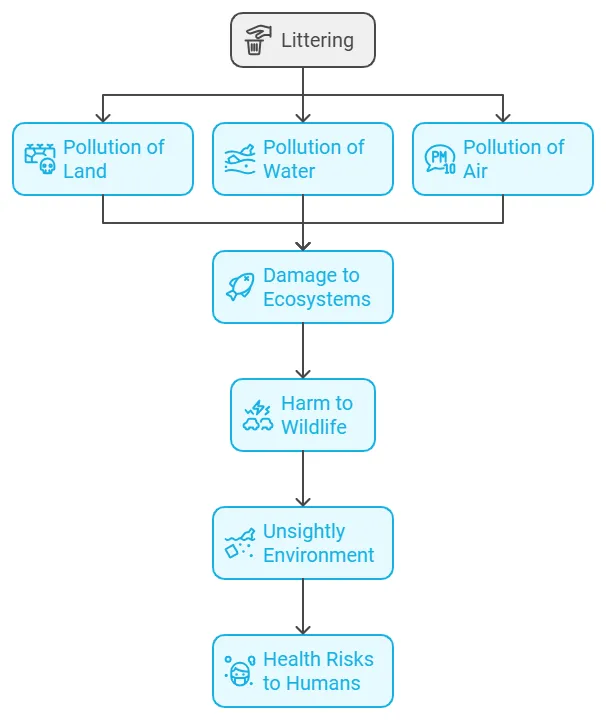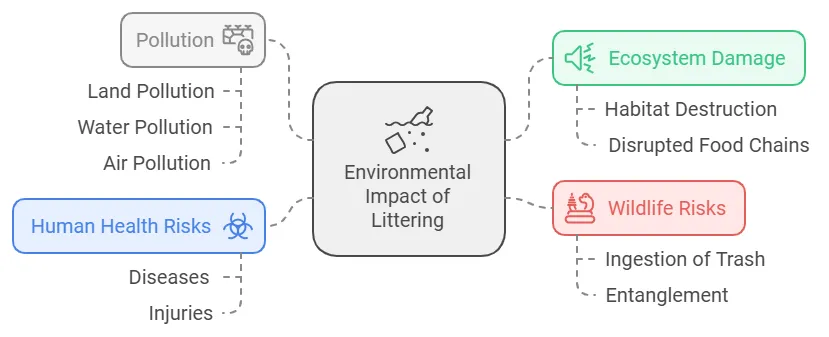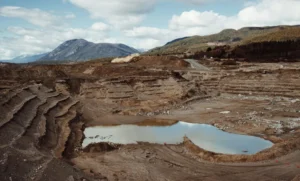Littering is harmful for the environment. It pollutes our land, water, and air, hurts animals, and makes our surroundings look ugly.
How does littering affect the environment really? Littering is a big problem that hurts our environment. Every year, millions of tons of trash are thrown away in the wrong places.
The impact of littering is not only visible but also involves some pretty hidden consequences such as the destruction of our earth. From pollution to injuring wildlife, problems in waste disposal bring very severe implications to our world.
It is a must to consider how littering prompts the injuries done upon the environment. Simple actions such as proper garbage disposing can make a great difference. It helps bring answers to the problems of protecting ecosystems, animals, and even ourselves from harm.

The Shocking Truth About Litter
- The World Bank says we make 2.01 billion metric tons of trash every year, and at least 33% of it isn’t thrown away in a safe way.
- Keep America Beautiful says there are about 50 billion pieces of litter on U.S. roads every year.
- The Ocean Conservancy picked up over 23 million pounds of trash from beaches and waterways around the world in just one year.
Environmental Impacts of Littering

Litter causes different kinds of pollution. Each causing environmental damage in its own way.
Water Pollution
Trash pollution from litter usually reaches the rivers, lakes, and oceans. Plastics are particularly broken down into smaller pieces, which can carry harmful chemicals to the water. This contamination harms marine life and makes water unfit for drinking and swimming. These tiny particles get swallowed by the fish, sea turtles, and other creatures, making them sick or killing them.
Soil Pollution
When wastes decompose, they do not disappear without a trace. The problem of disposing of waste is bad enough, but it gets even worse. Chemicals from plastics, plastic additives, and other materials can leak into the soil. These toxins can actually effect what we eat because they can find their way into the plants and animals that grow or live in contaminated areas.
When waste is burnt in landfills, harmful smoke finds its way to the air. The smoke linked to burning trash contaminates the atmosphere and may pose major health problems for people living around the environment. Those fumes have been known to cause respiratory problems and other diseases thus posing a threat to affect the environment and our health.
Impact on Wildlife
Litter doesn’t just cause pollution. It also has a big impact on wildlife.
Ingestion and Entanglement
Many animals mistake litter for food. The plastic bags seep into the digestive systems of marine animals like turtles, causing them to choke from inside. Birds and fish are caught in old fishing gears or plastic rings, causing injury or death. Over one million animals die each year because of litter-related issues.
Habitat Disruption
Litter can affect an animal’s habitat. For example, when a lot of rubbish reaches rivers or lakes, it can cause algal blooms, which use the oxygen that the fish and other life in the water need to survive. This disruption can ruin entire habitats, which in turn has a multiplied effect on the environment.
Visual Pollution
Besides harming nature, litter also leads to an environment that is unappealing to the eye. The view of litter and trash all over beaches, parks, and streets cheapens the community’s value. It also attracts other animals such as rats and insects, which pose extra health risks. The quality of life in those places becomes less attractive to living and visiting people when litter builds up.
What does littering do to the Environment

Decomposition Rates
Potentially the most shocking fact about trash is how long it stays around. Trash breaks down from hundreds to thousands of years. Here’s a breakdown of how long it takes some of the most common types of litter to decompose:
- Plastic bags: 100 to 1,000 years
- Glass: Up to 1 million years
- Cigarette butts: 10 to 12 years
- Aluminum cans: 80 to 200 years
- Food scraps: Up to 5 weeks
- Non-Biodegradable items such as Styrofoam or glass can take over 1 million years
Due to the fact that litter decomposes slowly, it continues causing environmental damage for generations.
Common Littered Items
- Plastic bottles
- Cigarette butts
- Food wrappers
- Aluminum cans
- Paper products
- Plastic bags
- Straws and stirrers
- Glass bottles
Economic Costs
It’s an expensive task to clear up litter. Local government spends billions of dollars in dealing with litter scattered by the careless disposal of waste. Taxpayer money that could otherwise be used for better environmental programs or community services is instead used in picking up trash. If we reduced that litter, the resources could be spent towards better use and with benefits of all.
The Bottom Line
The effects of littering goes beyond visual appeal; it causes real damage to the environment, harms wildlife, and in extreme cases, even threatens human health. This is how littering affects the environment. Proper waste management helps prevent such issues.
Everyone can contribute to reducing litter and protecting the planet by adopting proper disposal of garbage. Let’s work together for a clean environment and safe life for all living things.
FAQ's
How is littering harmful to the environment?
Littering is harmful for the environment. It makes our land, water, and air dirty, hurts animals.
What causes littering in the environment?
Littering is caused by carelessness and a lack of respect for the environment.
How does litter affect plants and animals?
Litter can pollute the environment, harm animals, and make it difficult for plants to grow.
What are the effects of waste on the environment?
Waste can pollute the environment, harm wildlife, and create health risks.




